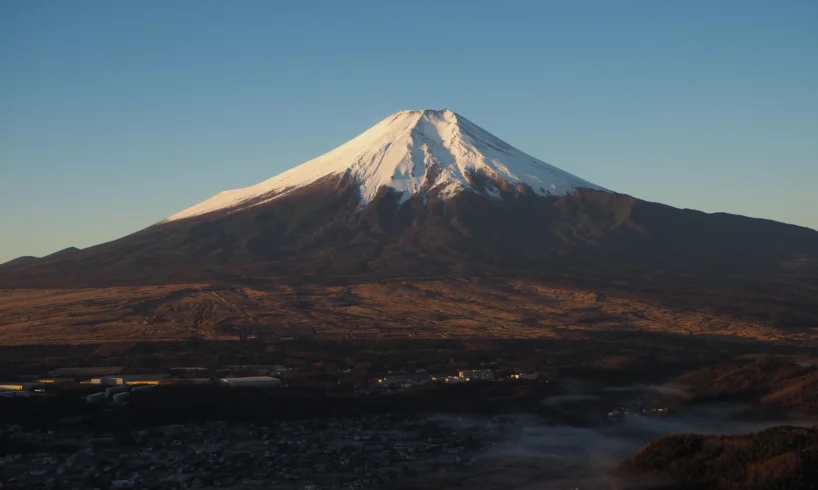
A wise man climbs Mount Fuji once, but only a fool climbs it twice. When Satoshi Chishiro hears these oft-cited words about Japan’s greatest mountain, he breaks into a smile. “I must be quite the fool then,” he says. Despite being in his early forties, Chishiro, who goes by Chiyo for short, has already summited Mount Fuji more than 50 times.
We meet some of Chiyo’s intrepid predecessors when we reach Kitaguchi Hongu Fuji Sengen Shrine in the forests outside the city of Fuji-Yoshida. This shrine is the starting point for one of the traditional routes up Mount Fuji that pilgrims and adventurers for hundreds of years have followed. Some of these climbers evidently shared Chiyo’s obsession.
Photo Credit: Satoshi Chishiro Mountain Guiding
“Look at this,” he says, gesturing to a large stone marker from the late 19th century. “This man put a monument up to celebrate 50 successful climbs—all the way from the base of the mountain to the top.” He takes me into the shrine’s main hall, which dates back to 1615, where there are wooden boards all over the walls filled with rows and rows of names.
“These are actual rosters from early climbing societies. That one is an expedition from Ueno, in Tokyo, that took place in 1901.”
Reading the names on these boards somehow makes the past seem less distant. I tell Chiyo that they remind me of the Kootenay Mountaineering Club, which my father helps run as a volunteer back in Canada. Chiyo agrees, but explains that the origins of mountaineering in Japan stem from two very different traditions.
“The idea of climbing mountains for fun, as a sport, really only came to Japan from the West during the Meiji period. In the Edo period and before, climbing a mountain was a far more spiritual exercise, kind of like going on a pilgrimage.”
Photo Credit: Satoshi Chishiro Mountain Guiding
While the Japanese term for modern mountaineering is tozan (登山), the word used before the Meiji period was tohai (登拝), a combined journey of climbing and prayer. “Back in those days, climbers would stop repeatedly along their way to pray, taking time to appreciate and contemplate their surroundings,” says Chiyo.
“Like many mountains in Japan, Mount Fuji was seen as an extremely sacred place. Its bare upper slopes were considered the realm of the spirits known as kami, where mortals were only welcome to visit, not stay.”
Photo Credit: Satoshi Chishiro Mountain Guiding
Chiyo leads me to a small stone torii gate at the back of the shrine. “This is the original starting gate,” he says with a grin. “Ready—go!” Peering upward through the trees, I ask how long it takes to reach the summit from here. Most climbers these days take a bus to the Fifth Station and hike from there to the top in about six hours.
“From here it’s around twelve hours if you really go for it,” Chiyo replies. “And if we’re talking about the old days, you have to remember that it took two or three days on foot just to get here from Edo.”
In theory, the emphasis was on embracing the hardships of the climb and the weather as an integral part of tohai. In reality, many sought ways to make their journey more comfortable and pleasurable. The town of Fuji-Yoshida experienced an economic boom catering to Fuji visitors during the Edo period, providing mountain porters and guides (much like the sherpas of Everest), ryokan-style lodging in temples and a lively red-light district.
Teahouses also sprang up along the mountain trail, including Naka no Chaya, located halfway between the shrine and Umagaeshi. This is where climbers once dismounted and left their horses. Naka no Chaya was known as Yukyo, marking the boundary between the mortal world and the spirit realm of the kami.
To learn more about Edo-period Japan, check out our articles:
A Tale of Edo Japan Timekeeping and Navigation
Katsu Kaishu: The Man Who Saved Edo from the Flames
Edo’s Inked Heroes: Edo Firefighters
Photo Credit: Satoshi Chishiro Mountain Guiding
“Until the Meiji period, only men were allowed to climb Mount Fuji,” says Chiyo, as we stand on the trail outside Naka no Chaya. “So, however spiritually enlightening these trips were supposed to be, there was also a bit of a boys-on-tour aspect to them, I think.”
He points up at the summit, still clad in its winter cap of snow. “They say that the reason Mount Fuji is so often veiled in clouds is that the goddess of the mountaintop coquettishly hides her face whenever an attractive male suitor arrives.”
I look up. Not a cloud in the sky. Damn.
Photo Credit: Satoshi Chishiro Mountain Guiding
Having spent time in the United States as a student, Chiyo’s dream is to share his passion for Mount Fuji with people from all over the world. This was what prompted him to found his guiding company thousandth, and to partner with Yamanashi wineries and local restaurants, like nôtori that showcase the region’s extraordinary agricultural abundance.
Above all, he hopes visitors will spend a bit more time getting to know the area. “I understand why people want to climb the mountain,” he says. “But there is so much more to Mount Fuji than just getting to the top.”
You might also be interested in our Guide to Hiking in Tokyo in Autumn. Or our Guide to Solo Hiking in Japan.





